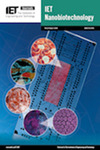
Iet Nanobiotechnology
期刊级别:SCI
- 国际刊号:1751-8741
- 国内刊号:--
- 期刊周期:--
- 主办单位:
 正刊通过真伪验证
正刊通过真伪验证 不成功全额退款
不成功全额退款
期刊介绍
SCIE期刊 学科领域:BIOCHEMICAL RESEARCH METHODS
Electrical and electronic engineers have a long and illustrious history of contributing new theories and technologies to the biomedical sciences. This includes the cable theory for understanding the transmission of electrical signals in nerve axons and muscle fibres; dielectric techniques that advanced the understanding of cell membrane structures and membrane ion channels; electron and atomic force microscopy for investigating cells at the molecular level.
Other engineering disciplines, along with contributions from the biological, chemical, materials and physical sciences, continue to provide groundbreaking contributions to this subject at the molecular and submolecular level. Our subject now extends from single molecule measurements using scanning probe techniques, through to interactions between cells and microstructures, micro- and nano-fluidics, and aspects of lab-on-chip technologies. The primary aim of IET Nanobiotechnology is to provide a vital resource for academic and industrial researchers operating in this exciting cross-disciplinary activity. We can only achieve this by publishing cutting edge research papers and expert review articles from the international engineering and scientific community. To attract such contributions we will exercise a commitment to our authors by ensuring that their manuscripts receive rapid constructive peer opinions and feedback across interdisciplinary boundaries.
IET Nanobiotechnology covers all aspects of research and emerging technologies including, but not limited to:
Fundamental theories and concepts applied to biomedical-related devices and methods at the micro- and nano-scale (including methods that employ electrokinetic, electrohydrodynamic, and optical trapping techniques)
Micromachining and microfabrication tools and techniques applied to the top-down approach to nanobiotechnology
Nanomachining and nanofabrication tools and techniques directed towards biomedical and biotechnological applications (e.g. applications of atomic force microscopy, scanning probe microscopy and related tools)
Colloid chemistry applied to nanobiotechnology (e.g. cosmetics, suntan lotions, bio-active nanoparticles)
Biosynthesis (also known as green synthesis) of nanoparticles; to be considered for publication, research papers in this area must be directed principally towards biomedical research and especially if they encompass in vivo models or proofs of concept. We welcome papers that are application-orientated or offer new concepts of substantial biomedical importance
Techniques for probing cell physiology, cell adhesion sites and cell-cell communication
Molecular self-assembly, including concepts of supramolecular chemistry, molecular recognition, and DNA nanotechnology
Societal issues such as health and the environment
Special issues. Call for papers:
Smart Nanobiosensors for Next-generation Biomedical Applications - https://digital-library.theiet.org/files/IET_NBT_CFP_SNNBA.pdf
Selected extended papers from the International conference of the 19th Asian BioCeramic Symposium - https://digital-library.theiet.org/files/IET_NBT_CFP_ABS.pdf
电气和电子工程师在为生物医学科学贡献新理论和技术方面有着悠久而辉煌的历史。这包括用于理解神经轴突和肌肉纤维中电信号传输的电缆理论;促进对细胞膜结构和膜离子通道理解的介电技术;用于在分子水平上研究细胞的电子和原子力显微镜。
其他工程学科以及来自生物、化学、材料和物理科学的贡献继续在分子和亚分子水平上为该学科做出开创性的贡献。我们的学科现在从使用扫描探针技术的单分子测量扩展到细胞与微结构之间的相互作用、微流体和纳米流体以及芯片实验室技术的各个方面。IET 纳米生物技术的主要目标是为从事这一激动人心的跨学科活动的学术和工业研究人员提供重要资源。我们只有通过发表来自国际工程和科学界的前沿研究论文和专家评论文章才能实现这一目标。为了吸引此类投稿,我们将履行对作者的承诺,确保他们的稿件能够迅速收到跨学科的同行建设性意见和反馈。
IET 纳米生物技术涵盖研究和新兴技术的各个方面,包括但不限于:
应用于微米和纳米级生物医学相关设备和方法的基本理论和概念(包括采用电动、电流体动力学和光学捕获技术的方法)
应用于自上而下纳米生物技术方法的微加工和微制造工具和技术
针对生物医学和生物技术应用的纳米加工和纳米制造工具和技术(例如原子力显微镜、扫描探针显微镜和相关工具的应用)
应用于纳米生物技术的胶体化学(例如化妆品、防晒霜、生物活性纳米颗粒)
生物合成(也称为绿色纳米粒子的合成;要考虑发表,该领域的研究论文必须主要针对生物医学研究,特别是如果它们包含体内模型或概念证明。我们欢迎以应用为导向或提供具有重大生物医学重要性的新概念的论文
探测细胞生理学、细胞粘附位点和细胞间通讯的技术
分子自组装,包括超分子化学、分子识别和 DNA 纳米技术的概念
健康和环境等社会问题
特别问题。征文:
用于下一代生物医学应用的智能纳米生物传感器 - https://digital-library.theiet.org/files/IET_NBT_CFP_SNNBA.pdf
第 19 届亚洲生物陶瓷研讨会国际会议精选扩展论文 - https://digital-library.theiet.org/files/IET_NBT_CFP_ABS.pdf
该刊已被国际权威数据库SCIE收录,该刊致力于发表经过严格同行评审的高质量原创文章,反映工程技术-纳米科技领域的新进展、新技术、新成果,促进该领域科研交流和科研成果转化。该刊2023年影响因子为3.8,平均审稿速度为 12周,或约稿 ,近四年来没有被列入预警名单。如果您需要投稿发表服务及指导,可以联系我们的客服老师,我们专业专注服务期刊投稿协助10年,为您提供期刊投稿个性化定制服务,并且我们确保严格保密您的个人信息及稿件内容。
CiteScore(2024年最新版)
由Elsevier提出,用来评估期刊学术影响力的指标
- CiteScore:6.2
- SJR:0.512
- SNIP:0.707
CiteScore 排名
| 学科 | 分区 | 排名 | 百分位 |
| 大类:Engineering 小类:Electrical and Electronic Engineering | Q2 | 202 / 797 |
74% |
| 大类:Engineering 小类:Electronic, Optical and Magnetic Materials | Q2 | 77 / 284 |
73% |
| 大类:Engineering 小类:Biotechnology | Q2 | 116 / 311 |
62% |
CiteScore:由Elsevier集团开发,类似影响因子用来评估杂志期刊学术影响力的一个指标。CiteScore采用了四年区间来计算每个期刊的学术引用。CiteScore拥有自带数据库Scopus,Scopus主要两个特点:一是免费面向所有人开放;二是采用透明的操作与计算,具有极高的可重复性。
由中国科学院国家科学图书馆制定出来的分区
2023年12月升级版
| 大类学科 | 分区 | 小类学科 | 分区 | Top期刊 | 综述期刊 |
| 工程技术 | 4区 | BIOCHEMICAL RESEARCH METHODS 生化研究方法 NANOSCIENCE & NANOTECHNOLOGY 纳米科技 | 4区 4区 | 否 | 否 |
2022年12月升级版
| 大类学科 | 分区 | 小类学科 | 分区 | Top期刊 | 综述期刊 |
| 工程技术 | 4区 | BIOCHEMICAL RESEARCH METHODS 生化研究方法 NANOSCIENCE & NANOTECHNOLOGY 纳米科技 | 4区 4区 | 否 | 否 |
2021年12月旧的升级版
| 大类学科 | 分区 | 小类学科 | 分区 | Top期刊 | 综述期刊 |
| 工程技术 | 4区 | BIOCHEMICAL RESEARCH METHODS 生化研究方法 NANOSCIENCE & NANOTECHNOLOGY 纳米科技 | 4区 4区 | 否 | 否 |
2021年12月基础版
| 大类学科 | 分区 | 小类学科 | 分区 | Top期刊 | 综述期刊 |
| 工程技术 | 4区 | BIOCHEMICAL RESEARCH METHODS 生化研究方法 NANOSCIENCE & NANOTECHNOLOGY 纳米科技 | 4区 4区 | 否 | 否 |
2021年12月升级版
| 大类学科 | 分区 | 小类学科 | 分区 | Top期刊 | 综述期刊 |
| 工程技术 | 4区 | BIOCHEMICAL RESEARCH METHODS 生化研究方法 NANOSCIENCE & NANOTECHNOLOGY 纳米科技 | 4区 4区 | 否 | 否 |
2020年12月旧的升级版
| 大类学科 | 分区 | 小类学科 | 分区 | Top期刊 | 综述期刊 |
| 工程技术 | 4区 | BIOCHEMICAL RESEARCH METHODS 生化研究方法 NANOSCIENCE & NANOTECHNOLOGY 纳米科技 | 4区 4区 | 否 | 否 |
基础版:将SCI期刊分为数学、物理、化学、医学、环境科学与生态学、生物、农林科学、工程技术、地学、地学天文、社会科学、管理科学及综合性期刊13个大类学科,再根据各大类期刊3年的平均影响因子进行划分。前5%为该类1区、6%~20% 为2区、21%~50%为3区,最后50%为4区,由高到低呈现金字塔状。
升级版:收录期刊涵盖了自然科学期刊(SCIE)、社会科学期刊(SSCI)和ESCI收录的中国期刊(自科+社科)(不包含A&HCI期刊和ESCI国外期刊)。从2022年起将只发布升级版。升级版涵盖254个小类的18个大类。为了更好描述期刊的主题表现,升级版设计了“期刊超越指数”取代影响因子指标。期刊超越指数,即本刊论文的被引频次高于相同主题、相同文献类型的其它期刊的概率。
JCR分区(2023-2024年最新版)
由科睿唯安公司(原为汤森路透)制定
| 按JIF指标学科分区 | 收录子集 | 分区 | 排名 | 百分位 |
| 学科:BIOCHEMICAL RESEARCH METHODS | SCIE | Q1 | 15 / 85 |
82.9% |
| 学科:NANOSCIENCE & NANOTECHNOLOGY | SCIE | Q3 | 71 / 140 |
49.6% |
| 按JCI指标学科分区 | 收录子集 | 分区 | 排名 | 百分位 |
| 学科:BIOCHEMICAL RESEARCH METHODS | SCIE | Q4 | 67 / 85 |
21.76% |
| 学科:NANOSCIENCE & NANOTECHNOLOGY | SCIE | Q3 | 87 / 140 |
38.21% |
JCR分区是由科睿唯安公司(原汤森路透,2016年易主科睿唯安)每年发布的,设置了254个具体学科,根据每个学科分类按照期刊当年的影响因子高低将期刊平均分为4个区,分别为Q1、Q2、Q3和Q4,各占25%。JCR分区包括自然科学(Science Edition)和社会科学(Social Sciences Edition)两个版本。其中,JCR-Science涵盖来自83个国家或地区、约2000家出版机构的8500多种期刊,覆盖176个学科领域。JCR-Social Sciences涵盖来自52个国家或地区、713家出版机构3000多种期刊,覆盖56个学科领域。
- 看看上一本期刊:Australian Journal Of Earth Sciences
- 看看下一本期刊:Lasers In Medical Science
期刊推荐

- Food Security
- 期刊级别:SCI
- 主办单位:
- 周期: --
- 国际刊号:1876-4517
- 国内刊号:--


- International Journal Of Oral Science
- 期刊级别:SCI
- 主办单位:
- 周期: --
- 国际刊号:1674-2818
- 国内刊号:--


- Clinical Microbiology Reviews
- 期刊级别:SCI
- 主办单位:UNITED STATES
- 周期: --
- 国际刊号:0893-8512
- 国内刊号:--


- International Journal Of Geographical Information Science
- 期刊级别:SCI
- 主办单位:
- 周期: --
- 国际刊号:1365-8816
- 国内刊号:--




